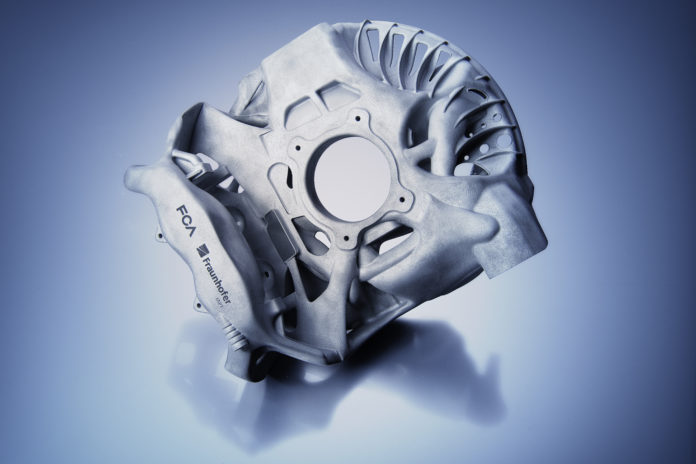Car manufacturer Fiat Chrysler partners with Fraunhofer Research Institution for Additive Manufacturing Technologies IAPT (Fraunhofer IAPT) to develop a 3D-printed wheel carrier with an integrated brake caliper for an FCA sports car.
Wheel carrier with integrated brake caliper
The additive research collaboration started with a bold question: How can a complete suspension system for a sports car be realized using 3D printing? At present, this system still consists of various individual parts such as the wheel carrier, brake caliper including hydraulics, and heat shield. In the past, these components were manufactured individually and then assembled in several steps using screws, seals, and washers to form a complete, functioning system. All in all, a complex, time-consuming, and expensive process.
“We had, together with the FCA design team, to completely rethink the entire wheel suspension in order to achieve a one-piece bionic structure that fulfilled all the functions of the previous assembly at least equally as well, absorbed all the forces, was weight-optimized, and could be produced additively,” says IAPT design engineer Yanik Senkel
Eco-efficiency through lightweight and integral design
The result is impressive: By using topology optimization, the team has developed a prototype that weighs 36% less than the 12 individual parts of the conventionally manufactured component. The bionically optimized design reduces the assembly effort enormously, increases the fatigue strength thanks to the more robust construction and should also perform better in terms of noise, vibration, and harshness (NVH). The clever integral design eliminates many typical weak points and therefore extends its lifetime. “The component demonstrates the potential of Additive Manufacturing for future cars,” says Carcioffi proudly ”and on top of that it’s a real eye-catcher,” he adds.
The part represents the first step towards serial 3D printing of FCA vehicle components. Commenting on these ambitious goals, Carlo Carcioffi, Head of Advanced Processes and Materials Body, Interiors, Chassis, says: “Together with our innovation partner Fraunhofer IAPT, we are cutting the costs and production effort for key vehicle parts. The knowledge transfer will help us to improve Additive Manufacturing competence in the fields of integrated design, materials, and process technology across the group.”
In numerous joint workshops, which also covered the areas of material and process development and quality assurance, several components in lightweight and integral construction were completely redeveloped.
But which vehicle parts does the cooperation team identify as the next 3D printing candidates? The results should be exciting, states Carcioffi confidently.
Remember, you can post free of charge job opportunities in the AM Industry on 3D ADEPT Media or look for a job via our job board. Make sure to follow us on our social networks and subscribe to our weekly newsletter : Facebook, Twitter, LinkedIn & Instagram ! If you want to be featured in the next issue of our digital magazine or if you hear a story that needs to be heard, make sure to send it to contact@3dadept.com






